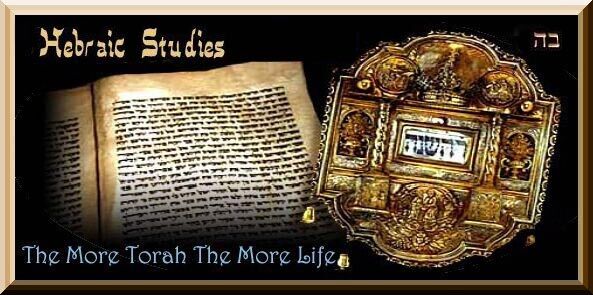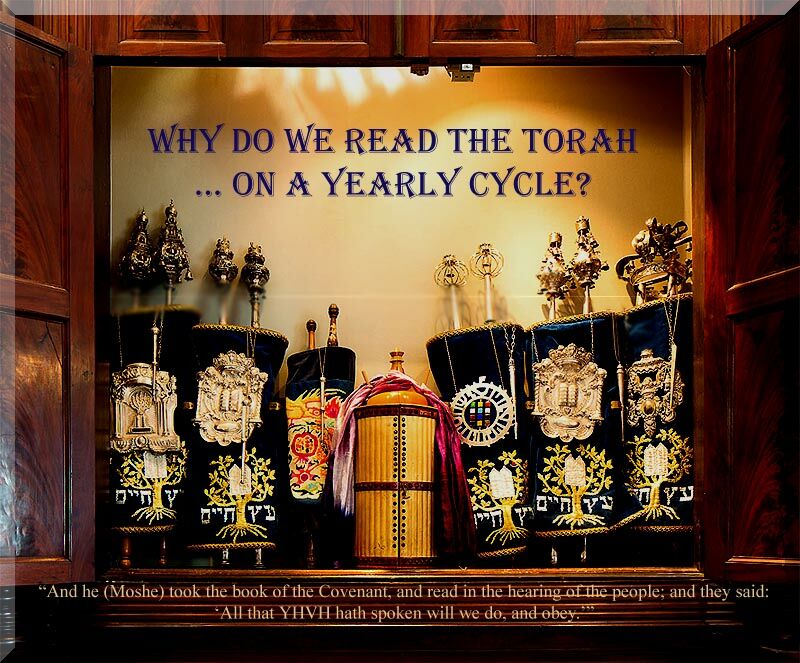Why we Read the Torah on a Yearly Cycle
Please Note: Firefox and some other search engines
are not suitable
Use Google
Chrome for this
page to load perfectly!

Please
do NOT
visit this site on Shabbat or on a
![]() -
Y-H-V-H, which we usually pronounce as “Adonai” or “HaShem”.
-
Y-H-V-H, which we usually pronounce as “Adonai” or “HaShem”.
*“This is My Name forever,
and this is My memorial to all generations.”
Shemot - Exodus 3:15.
Although some minor alterations have been made relating to names and attributes having been corrected.
Please Note: Verse numbers may at times vary in non-Jewish Bibles.

The
history of the weekly portion and the different schedules on which it's done.
The first mention of a scheduled Torah-reading
cycle appears in the Bible, in Deuteronomy, where Moses instructs the tribe of
Levi and the elders of Israel to gather all the people for a public reading
from portions of the Torah once every seven years. The need to read the Torah
publicly intensified after the destruction of the
And that became all because rabbis decided and a reference was added in the Mishnah (the first effort to permanently record Jewish custom and law, compiled in the 3rd century C.E.) supported Deuteronomy’s prescription, we understand that Jews were continuing to read the Torah publicly; and we also know that there were Torah readings for festivals, special Shabbatot (plural of Shabbat) and fast days.
But it was not until about the 6th century
C.E., that the Jews in the
The Jews of Babylon, however, followed a different custom, established by the beginning of the 7th century CE, and completed the entire cycle each year, which they did by dividing the Torah into 54 weekly portions. (Because the number of portions exceeds the number of weeks in a given year, more than one portion is read during certain weeks.) In Hebrew, the word for portion is parsha (plural, parshiyot).
In the 19th century, a reintroduction of the
Palestinian triennial cycle was attempted at the West End Congregation in
The reintroduction failed for two reasons. First, in the pattern of the Palestinian triennial cycle, the weekly reading would have differed from what the rest of the Jewish world was reading. Second, Simchat Torah (the holiday in which Jews celebrate the conclusion of one Torah-reading cycle and the beginning of the next) celebrations would occur only one out of every three years, instead of annually.
Finally, in 1988, the Committee on Jewish Law and Standards of the Conservative Movement passed a legal responsum that put into practice a new American triennial cycle. This new triennial cycle, rather than dividing the entire Torah into thirds, as was done in the Palestinian cycle, divides each of the individual 54 portions into thirds. Therefore, a congregation can be reading within the same portion as those who follow the annual cycle, but will only read one-third of each portion per year. In addition, this pattern enables the congregation to read from Bereshit - Genesis through Devarim - Deuteronomy each year, providing for an annual celebration of Simchat Torah.
There is an obvious drawback to this system:
Only one-third of each conventional Torah portion is actually read per year;
and the readings, because incomplete, do not flow smoothly into the portion of
the following week. Nonetheless, the vast majority of American Conservative and
Reform congregations prefer this new cycle. All Jews in
Below is a short Torah based addition:
![]()
At Home in Torah
Judaism's sacred texts are a refuge and a place to grow.
Why does our blessed Torah begin with the
letter “bet - ![]() ? The question
receives many answers in Jewish tradition. One common answer is that since
“bet” -
? The question
receives many answers in Jewish tradition. One common answer is that since
“bet” - ![]() is the second letter, it
shows there is no true beginning to study, it is an everlasting
enterprise. Elie Wiesel answers
it this way:
is the second letter, it
shows there is no true beginning to study, it is an everlasting
enterprise. Elie Wiesel answers
it this way:
“Bet is a house (both because of its shape and because it begins the word Bayit, home) … The Book of Books is a shelter, a dwelling place. A place in which men and women laugh and weep, read and write, work and sleep. A place in which people love one another before they start quarreling or the other way around. In other words, it is a home.”
To study the Torah is to enter a world in which we can be at home. Like home it invites us to enter, again and again. Like home, it is sometimes uncomfortable, too close or suddenly alien to us. Like home, at times it forces us to live with people who irritate or upset us. But always it calls us back. It is both a spur and a refuge. Study the Torah, it is like coming to a safe home!
Always remember our motto seen on the logo at
the top of this page: “The
More Torah, the More Life”, for ![]() Elohim, blessed be His Sanctified Name, is the
one who gave us our Life!”
Elohim, blessed be His Sanctified Name, is the
one who gave us our Life!”
![]()
Return to our MAIN PAGE or go to our Main Index

